Contents
- Description
- How vanilla looks like
- How and where it grows
- How to grow vanilla at home?
- Types and varieties
- How are vanilla pods obtained?
- Chemical composition, calorie content
- Aroma and taste
- How to choose and where to buy
- How to store
- The benefits and harms of vanilla
- Harm and contraindications
- Cooking Uses: How to Use a Vanilla Pod
- Where are vanilla pods added?
- Dosage
- Substitutes
- Cosmetology
- Vanilla in medicine
- 7 interesting facts about vanilla
- Natural vanilla sugar at home
Description
Appetizing sweet scent of baked goods and sweetish aroma of perfume – vanilla gives this special zest to desserts and cosmetics. Don’t confuse this expensive spice with the more affordable synthetic vanilla.
Vanilla is a fragrant sun-dried fruit of an edible fruiting orchid grown in the tropics. It is a long, thin pod of dark brown color.
The fresh vanilla pod has almost no flavor. The aromatic properties are revealed as a result of heating and fermentation.
The aroma and taste of real vanilla is a harmonious composition of about 200 natural substances.
Difficult cultivation and painstaking processing have led to the fact that it is very expensive.
Vanilla is mainly used to flavor sweet foods:
- cupcakes;
- cookies;
- puddings;
- cakes;
- custard;
- ice cream;
- drinks;
- sweets;
- chocolate.
To reduce the cost of these products, a synthetic substitute was developed – vanillin. Its price is about 5% of the price of real vanilla, and the smell is very far from the intensity and harmony of the original. Due to its cheapness, vanillin is very common, although its artificial taste is absolutely inedible for some gourmets.
How vanilla looks like
Vanilla looks like a dark brown pod, usually 17 to 23 cm long, weighs about 5 g, and contains about ½ teaspoon of small seeds.
How and where it grows
Vanilla is a flowering vine of the orchid family. It grows by twisting around trees. Mexico is considered its homeland, those regions of the country where tropical forests are common.
The vine has many deep orange-yellow, pipe-like flowers, which are so complex that not all types of bees can pollinate them.
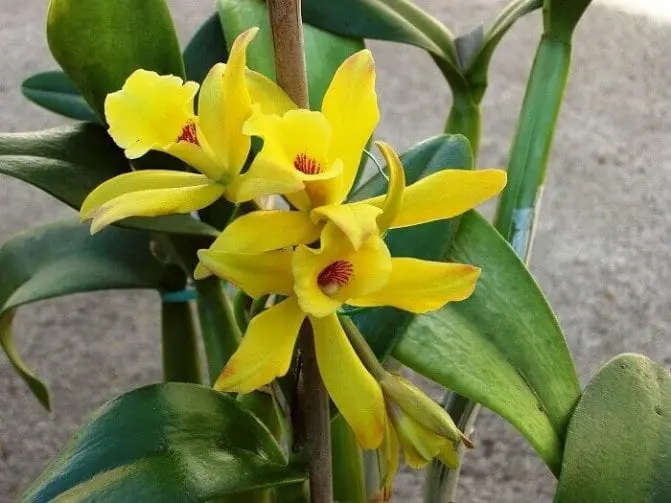
Vanilla orchid blooms and bears fruit only in the third year. Flowers only open for one day. In their natural habitat at this moment they should be pollinated by a certain type of bee or hummingbird – with long beaks. On farms, they are manually pollinated.
Further, the fruits are formed and ripen within 9 months. Ripe vanilla fruits are juicy pods (called pods or beans) filled with small, light seeds.
Vanilla orchids grow in tropical climates including Mexico, Tahiti, Reunion, Mauritius, Comoro, Indonesia, Uganda, and Tongo. Three quarters of the world’s supply comes from Madagascar. Madagascar alone accounts for 80% of world production.
Today, almost all countries with tropical and subtropical climates cultivate this spice. Among the leaders in vanilla production:
- Madagascar;
- Reunion Island in the Indian Ocean;
- Indonesia;
- an exotic plant is grown in Central America, Tahiti and Ceylon.
The high price of the spice is explained by the difficulty of cultivation – only manual labor is used in the process of growing, pollination, collection and processing of fruits. No chemicals and technical devices are used.
In addition, vanilla ripens for a long time – about 9 months. It takes a lot of work, applying intuition and experience to get a valuable product.
The flower is pollinated in a special way, you need to know how to connect the stamen and pistil. This handmade sacrament is called “vanilla wedding”.
If successful, a stick pod will appear from the flower, which has a dark brown, almost black color, it is oily and pliable to the touch.
How to grow vanilla at home?
The process is too delicate and laborious, the liana needs to create conditions that are almost impossible to achieve at home. So the maximum is to grow an orchid vine that will decorate the room. But to bloom and bear fruit … this is already something akin to a miracle.
Types and varieties
There are over 110 types of vanilla orchids. The most popular of them is flat-leaved (Vanilla planifolia). Almost 99% of all vanilla is made from it.
These types are mainly found on sale:
- Bourbon (Vanilla planifolia) or Madagascar – rich, sweet, subtle.
- Mexican – with a softer taste.
- Tahitian (Vanilla tahitiensis) – it has the darkest and thickest pods. It has a very strong aroma that sometimes even seems almost artificial. Used mainly in perfumery.
- Indian – with caramel notes in the aroma.

How are vanilla pods obtained?
The vanilla fruits themselves, which are harvested unripe, have no aroma. It is formed in the process of long correct preparation.
The collected liana pods undergo painstaking processing:
- they are briefly placed in hot water;
- then removed and left to dry and ferment in the fresh air – at least a week. The pods are wrapped in blankets and kept under the sun for a certain time, increasing it every day;
- the next stage is drying the fruit in the shade (up to several months), until the pod is covered with a bloom of thin white crystals of vanillin. Its total spice composition is not more than 3%, but it is to him that vanilla owes its wonderful smell;
- ripe pods are sorted and sent to the warehouse for packaging.
What quality the vanilla will end up with depends on the type of liana from which the fruits are collected, and on compliance with the cooking technology. During this process, the raw material loses up to 2/3 of its weight, but acquires a unique aroma.
Chemical composition, calorie content
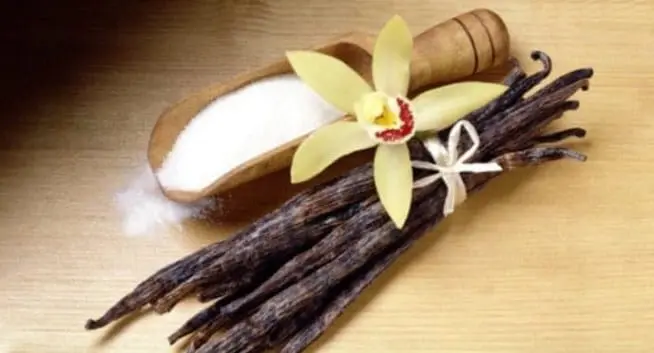
What is the calorie content of vanilla? 100 g of the spice contains 288 kcal.
It has a rich chemical composition:
- mineral salts, easily digestible carbohydrates;
- vitamins – PP, thiamine, riboflavin, B5, B6;
- macronutrients – first of all, potassium, as well as magnesium, calcium, sodium, phosphorus;
- trace elements – iron, zinc, copper, manganese;
- omega fatty acids.
- Vanilla contains essential oils, tannins, glycoside glucovanillin, which is converted into vanillin and glucose during fermentation by splitting.
Aroma and taste
Real vanilla has a rich, exotic and memorable scent. It is described as soft, fruity and sweet with woody and smoky notes. Vanilla tastes slightly bitter, but it has a floral sweetness. The aroma is released when heated.
Once you’ve tasted vanilla, you don’t want to use synthetic vanilla anymore. It cannot be compared to the exquisite taste and complex aroma of natural spice.
How to choose and where to buy
Real vanilla can be found in specialty seasoning stores. It is rarely found in regular supermarkets, and most often it is a low quality product.
The pods are sold individually or in small bundles packed in a long tube or jar.
Quality vanilla pods should be:
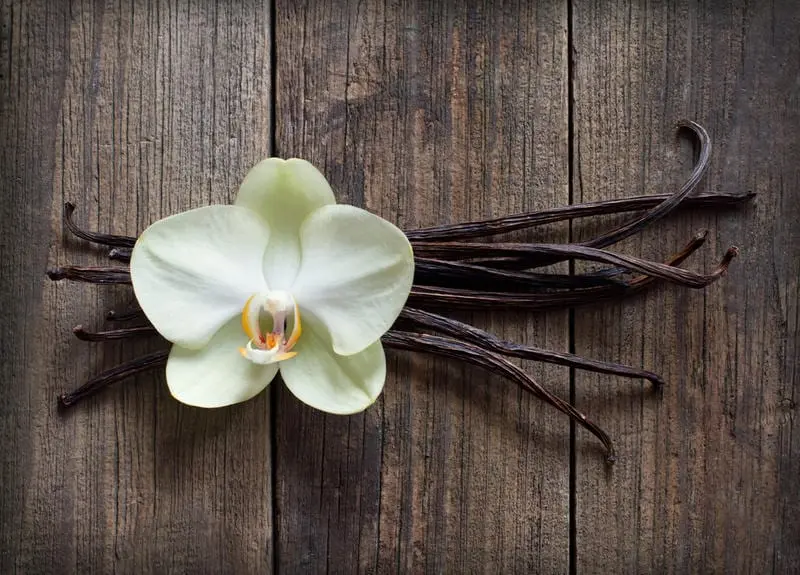
- whole, well filled along the entire length;
- with a thin, oily peel;
- flexible, easy to bend and fold into a ring, slowly straightening;
- uniform color from brown to chocolate shade;
- at least 14-16 cm long, about 1 cm wide;
- free of stains and damage (permissible cracks along the pod no more than 3 cm);
- slightly covered with a crystalline bloom – natural vanilla, responsible for the taste of vanilla.
- If the pods are old and dry, they are dull, brittle, and very difficult to extract seeds from.
Vanilla is often counterfeited by soaking the pods of other plant species in artificial flavors, even metal rods are mixed. To avoid counterfeiting, buy products only from well-known global manufacturers.
How to store
In sealed factory packaging, good quality whole vanilla pods are stored for 3-4 years from the date of production.
After opening the package, wrap the beans in wax paper or plastic wrap, then place in a glass container with a tight-fitting lid. Store at room temperature in a dark place. Vanilla shelf life under such conditions is up to two years.
Air out the jar for 10-15 minutes every few weeks to restore moisture to the dried pod.
Do not keep the spice in the refrigerator, as excess moisture can lead to mold growth.
It is best to use vanilla sticks within six months, as they dry out over time, even in the best conditions.
The benefits and harms of vanilla
The benefits of using vanilla are much greater than the harmful effects. Although it is worth knowing about the negative effects of this spice, about contraindications to its use.
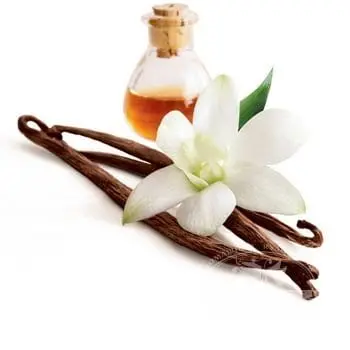
Beneficial features
Why the spice is useful:
- has a positive effect on the nervous system – has a sedative, relaxing effect, improves mood;
- normalizes the digestive process, regulates appetite, improves metabolism;
- has a beneficial effect on the skin – relieves acne, whitens, makes it more elastic;
- helps in the prevention of diabetes, hormonal problems;
- improves well-being during menstruation;
- plays the role of a strong aphrodisiac.
Harm and contraindications
The harmful effects of vanilla are that the spice can:
- cause allergic reactions;
- increase susceptibility to ultraviolet rays – after using vanilla essential oil in the sun, it is undesirable to be;
- intoxicate with a specific aroma.
It is contraindicated to use the spice:
- people with individual intolerance;
- women during pregnancy and lactation;
- children.
Cooking Uses: How to Use a Vanilla Pod

If the recipe requires a whole stick of vanilla, open it and then remove the seeds. For this:
- Place the tip of a sharp knife in the center of the pod just below the top of the pod, hold the knife at an angle and slowly cut through the pod to the tip, but not through, holding the top of the pod with two fingers.
- Open the pod slightly, turn the knife perpendicularly and slide it through the entire inside of the leaves, cleaning out the seeds.
- Repeat several times to scrub everything.
Use the seeds immediately, they cannot be stored for a long time. If only part of the pod is needed, use a sharp knife to cut the desired amount and follow the instructions given.
String vanilla is a spice, without which many dishes would not have such a unique taste, and, most importantly, aroma.
The natural spice is far from cheap, so it is used more often in the menus of respectable restaurants and expensive cafes. In the confectionery industry, cheaper vanilla analogs are preferred.
The famous Guryev porridge today is a real delicacy. And it turns out that it cannot be fully prepared without the use of aromatic seasoning.
Where are vanilla pods added?
Natural spice is used mainly for flavoring top quality confectionery products:
- exclusive chocolate;
- fillings for expensive sweets;
- nut and Christmas cookies;
- creams for gourmet cakes;
- premium alcoholic beverages.
If the price of the issue does not matter, then there are a lot of options for how to use the pod:
- for flavoring ice cream;
- as an important flavoring component of biscuits, puddings, soufflés;
- as an additive to dairy products – yoghurts, cream, curd spreads;
- in the manufacture of drinks – liqueurs, coca-cola, cocktails.
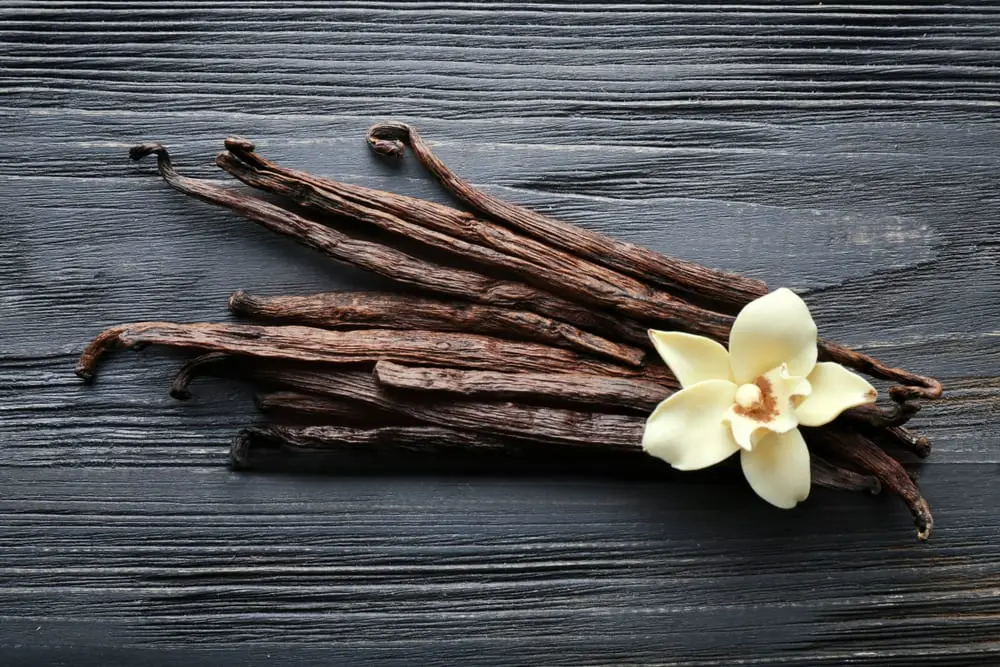
The confectionery industry often uses vanillin as a more affordable additive to products:
- jelly, mousse;
- jams, preserves;
- compotes, fruit drinks;
- glaze, syrups.
Vanilla is flavored not only with sweets – if you mix spice seeds with olive oil, the resulting substance will favorably set off the taste of dishes from meat, poultry, seafood, sauces.
Dosage
Have you always believed that a spice with a sweet aroma should taste right? In the case of vanilla, everything is different – it is bitter. Therefore, it is so important to observe the exact dosage in order to enrich the taste of the dish, and not spoil it.
The correct proportions are:
- a quarter of a vanilla stick will go to 1 kilogram of product;
- 1/20 of the pod is enough for 1 serving.
- Vanilla sugar for dough or sprinkling on a finished dish is done as follows: powdered sugar (0.5 kg) is ground with 1 spice pod.
What is the dosage of vanilla essence? For 6 servings of the dish, 3 drops are enough.
Substitutes
Since the vanilla pod is a spice, not everyone can afford to use it often.
Therefore, vanillin, an artificially synthesized product, is actively used in cooking. There are certainly bags with such a confectionery seasoning in every home.
What else can you replace the vanilla pod with:

- Vanilla extract – small spice pods infused in an alcohol solution.
- Essence – a more concentrated infusion of vanilla.
- Vanilla powder – crushed plant pods.
- Vanilla sugar – natural (the pods are covered with sugar and, tightly closed, insist 7 – 10 days) and artificial (sugar is mixed with vanilla).
Cosmetology
The beauty industry has found use of the beneficial properties of vanilla in decorative cosmetics – the spice is included in creams and hair products. And also the aroma of vanilla is loved by perfumers.
Cosmetology develops products based on vanilla extract and essential oil.
Cosmetic preparations with vanilla have a beneficial effect on the skin:
- whiten and remove pigmentation;
- reduce irritation, soothe;
- promote moisturizing and softening;
- tone up, making the skin more elastic;
- counteract the harmful effects of the environment.
- Vanilla creams belong to the line of expensive cosmetics.
Spice as one of the components is a part of hair cosmetics: shampoos, conditioners, balms, gels.

A valuable natural product – vanilla oil, beauticians advise to use it as hair masks. Its beneficial effect is to nourish, moisturize the skin and strands thanks to its active substances. With just a few drops of vanilla oil added to the hair mask, curls will be silky and voluminous.
Vanilla oil is used to prepare:
- relaxing bath mixtures – they also include honey, milk, cream, rose oil;
- scrub for cellulite based on ground coffee beans and almond oil.
- Vanilla oil is used in massage – it helps nourish the skin, eliminate inflammation, relieve tension.
Vanilla in medicine
The pharmaceutical industry uses vanilla in the production of herbal preparations.
Reference: Galenic preparations are medicines that are obtained by means of extraction from plant materials. They are in the form of tinctures and extracts (alcoholic and aqueous).
Agents that contain vanilla are used in therapy:
- seizures, to stimulate muscle activity;
- stomach ulcers, colitis, digestive problems;
- anemia, vitamin deficiency;
- insomnia;
- pain during menstruation;
- climacteric disorders;
- disorders of the nervous system;
- problems of a sexual nature – to increase libido.
- The pharmaceutical industry uses vanilla as a flavoring agent for drugs. Healing essential oil is produced from the plant. Its consistency is thick and viscous, the aroma is persistent and spicy.
In aromatherapy, vanilla oil is used to relieve stress and irritation, normalize sleep, and relax. The aroma of the spice helps the body produce serotonin, the hormone of joy and pleasure. Essential vanilla oil is effective in treating ENT diseases.
7 interesting facts about vanilla
The smell of vanilla contributes to the production of the “pleasure hormone” – serotonin. Vanilla pods are one of the most expensive spices in the world. Why – in more detail in 7 facts.

- The botanical distribution, that is, the places where vanilla grows, are concentrated around the equator. Why is it important to know? Because vanilla is one of the most expensive spices in the world, along with saffron. By a large margin, they are followed by nutmeg and pink peppercorns.
- To put it very roughly, vanilla is an orchid, and the coveted pod itself is the fruit of a flower that forms after flowering. Pricing is influenced by both the popularity of the spice, high demand, and the laboriousness of growing vines. Even with artificial pollination, only half of the flowers bear fruit.
- The homeland of vanilla is considered to be Central America, or more precisely, Mexico. It is there that to this day it can be found in the wild. It also hosts the Vanilla Festival, which is celebrated in June. The scent spreads in the air for several kilometers.
- Of more than a hundred known plant species, only three are cultivated and specially grown – Vanilla planifolia Andrews – the best pods up to 25 cm long, grown mainly in Madagascar; Vanilla pompona Schiede – shorter, but equally good quality pods; Vanilla tahitensis J.W. Moore – Lower quality Tahitian vanilla.
- In the 14th century, the Aztecs used vanilla pods as money. They could buy the necessary food, goods, they paid taxes.
- Vanillin, a synthetic substitute for natural vanilla, has nothing to do with vegetable pods. Colorless crystals have the chemical formula C8H8O3. Vanillin has been synthesized since 1858, using as a basis substances from, first, pine bark, and later clove oil, lignin (waste from paper production), rice bran, and now completely from petrochemical raw materials.
- Vanilla pod seeds are highly prized in cooking. Despite their bitter and intense taste, they are most often used as a flavoring agent for confectionery and dairy products.
Natural vanilla sugar at home
The easiest home recipe is vanilla sugar. You can flavor both refined white (beetroot) and dark, cane sugar. To do this, take one vanilla pod, cut it lengthwise and scrape off the seeds with a knife. Mix them in a resealable container (jar, sugar bowl) with 500 g of sugar, put the remaining pods there and leave for 3-5 days, tightly closing the lid. The longer they stand, the more intense the aroma will be. Such sugar can be used in baked goods or as a sweetener for tea, coffee, compotes, jelly.









